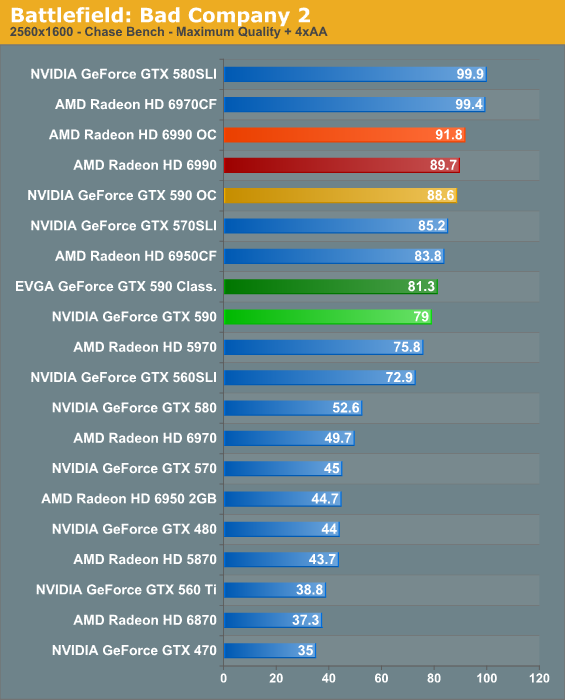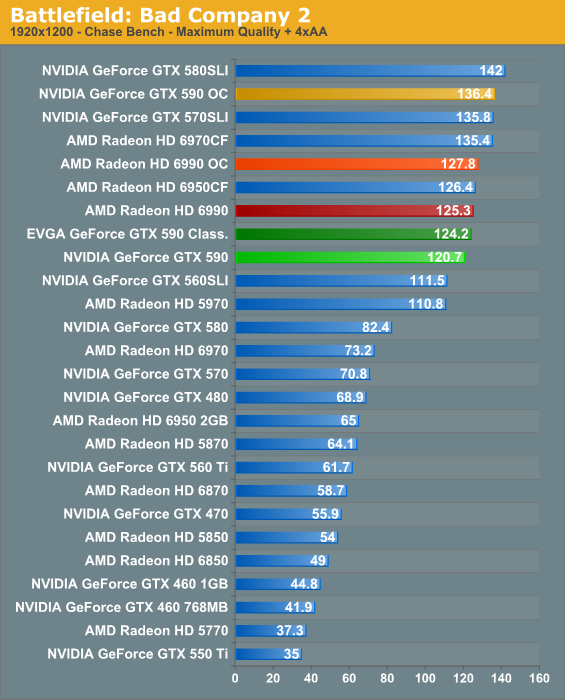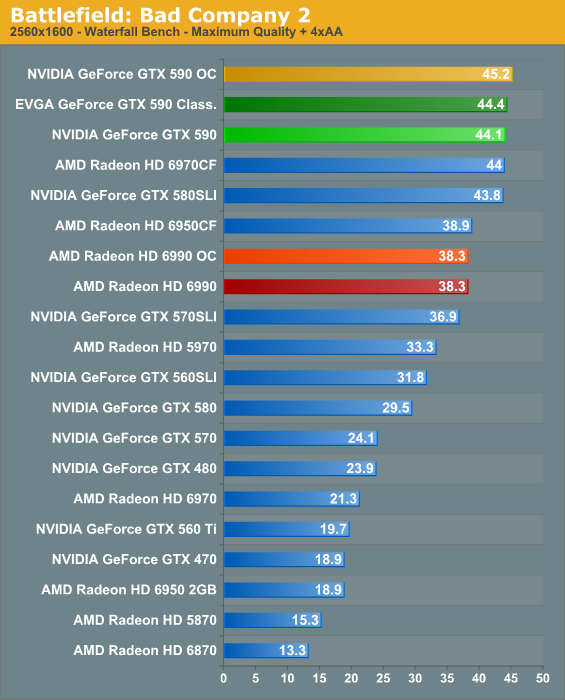NVIDIA’s GeForce GTX 590: Duking It Out For The Single Card King
by Ryan Smith on March 24, 2011 9:00 AM ESTBattlefield: Bad Company 2
Now approaching a year old, Bad Company 2 remains as one of the cornerstone DX11 games in our benchmark suite. Based on the Frostbite 1.5 engine, it will be replaced in complexity by the DX10+ only Frostbite 2 engine (and Battlefield 3) later this year. As BC2 doesn’t have a built-in benchmark or recording mode, here we take a FRAPS run of the jeep chase in the first act, which as an on-rails portion of the game provides very consistent results and a spectacle of explosions, trees, and more.


Historically Bad Company 2 favors two patterns in our tests: it favors shader speed, and it just favors AMD in general. Today is no exception, and while the GTX 590 can hit nearly 80fps, that’s still 10fps short of the 6990. Given that it’s normally shader bound our overclocked cards pick up the slack, but it’s not enough—not even the GTX 590 OC can reach the 6990, let alone an overclocked 6990.

Meanwhile our water benchmark gives us a good idea of what minimum framerates are like. Interestingly NVIDIA more than chips away at AMD’s lead here, and the GTX 590 and its overclocked variants top the charts. Given these scores it’s likely we’re approaching a non-GPU bottleneck in the game.










123 Comments
View All Comments
Ryan Smith - Thursday, March 24, 2011 - link
One way or another we will be including multi-monitor stuff. The problem right now is getting ahold of a set of matching monitors, which will take some time to resolve.fausto412 - Thursday, March 24, 2011 - link
also would be nice to test 1680x1050 on at least a couple of demanding games. illustrate to people who have 22" screens that these cards are a waste of money at their resolution.bigboxes - Thursday, March 24, 2011 - link
It has been a waste for that low resolution since two generations ago. But you knew that. Troll...tynopik - Thursday, March 24, 2011 - link
matching monitors might matter for image quality or something, but for straight benchmarking, who cares?surely you have 3 monitors capable of 1920x1080
it's not like the card cares if one is 20" and another is 24"
7Enigma - Thursday, March 24, 2011 - link
I don't understand this either. There is no need for anything fancy, heck you don't even need to have them actually outputting anything, just fool the drivers into THINKING they are driving multiple monitors!DanNeely - Thursday, March 24, 2011 - link
I don't entirely agree. While it doesn't matter much for simple average FPS benches like Anandtech is currently doing, they fall well short of the maximum playable settings testing done by sites like HardOCP.strikeback03 - Thursday, March 24, 2011 - link
Remember, the AT editors are spread all over. So while between them they certainly have at least 3 1920x1080/1200 monitors, Ryan (doing the testing) probably doesn't.Plus with different monitors wouldn't response times possibly be different? I'd imagine that would be odd in gaming.
tynopik - Thursday, March 24, 2011 - link
> Remember, the AT editors are spread all over. So while between them they certainly have at least 3 1920x1080/1200 monitors, Ryan (doing the testing) probably doesn't.This has been a need for a while, and it's not like this review was completely unexpected, so not sure why they don't have a multi-monitor setup yet
> Plus with different monitors wouldn't response times possibly be different? I'd imagine that would be odd in gaming.
Well that's sort of the point, they wouldn't actually be gaming, so who cares?
Martin Schou - Thursday, March 24, 2011 - link
I would have thought that the marketing departments of companies like Asus, Benq, Dell, Eizo, Fujitzu, HP, LaCie, LG, NEC, Philips, Samsung and ViewSonic would cream their pants at what is really very cheap PR.Supply sets of 3 or 5 1920x1080/1920x1200 displays and 3 or 5 2560x1440/2560x1600 displays in exchange for at least a full year's advertisement on a prominent tech website.
If we use Dell as an example, they could supply a set of five U2211H and three U3011 monitors for a total cost of less than 5,900 USD per set. The 5,900 USD is what us regular people would have to pay, but in a marketing campaign it's really just a blip on the radar.
Now, excuse me while I go dream of a setup that could pull games at 9,600x1080/5,400x1920 or 7,680x1600/4,800x2560 :D
Ryan Smith - Friday, March 25, 2011 - link
I'd just like to note that advertising is handled separately from editorial content. The two are completely compartmentalized so that ad buyers can't influence editorial control. Conversely as an editor I can't sell ad space.